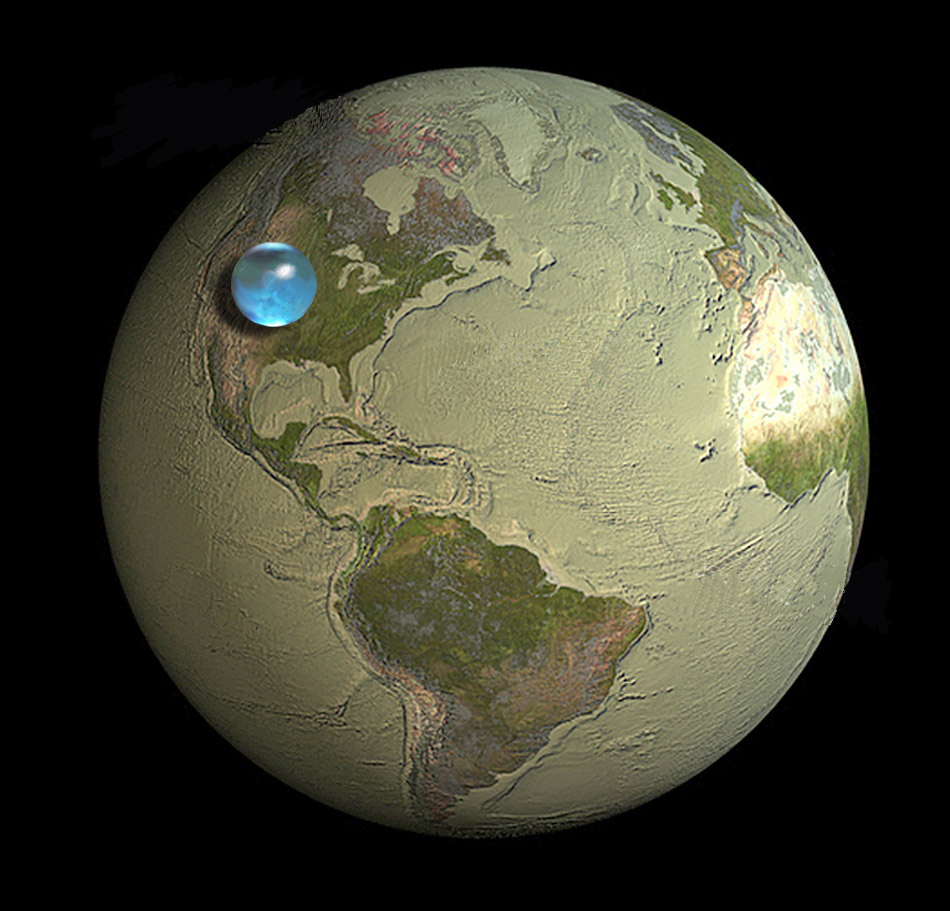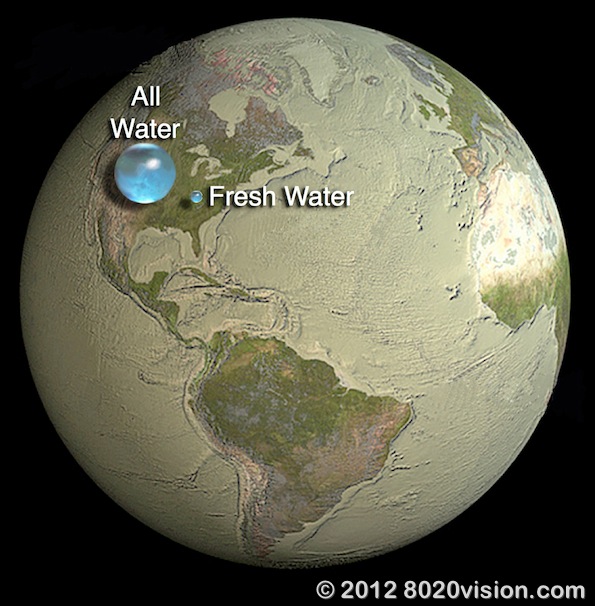The US Geological Survey (USGS) recently published a remarkable image helping us appreciate the preciousness of water. We have all probably heard the oft-quoted statistic that about how 70 percent of the Earth’s surface is water-covered – most of it in the form of oceans. Though it sounds like a lot, if we gathered all that water up, how much space would it take up? The USGS, in the image below, shows us that the answer is… not much.

Though about 97% of Earth’s water is in the form of oceans, these oceans are shallow compared to the Earth’s radius – just a couple miles deep. The image above shows us just how shallow the oceans are, using radar image data, mapping the bottom of the ocean. The blue sphere shows what would be required to contain all Earth’s water – from oceans, lakes, rivers, glaciers, snowpack, etc. The sphere has a radius of just 700 kilometers.
When this picture appeared in the news, I found myself wondering what portion of that sphere was fresh water. I noted a number of reader comments asking the same thing. It’s an important question. The Food and Agriculture Organization of the United Nations (FAO) projects that two-thirds of the planet will be water stressed by 2025. Safe drinking water and abundant water for irrigation will become increasingly scarce.
So what size sphere would be required to hold all the accesible fresh water in the world? The picture below shows the answer. But first, using USGS water data, let’s look at how the size of that fresh water sphere was calculated:
The Math:
- As the USGS demonstrated, all Earth’s water (1,386,000,000 cubic kilometers) can be contained in a sphere with radius of about 693 kilometers.
- Of that water, only about .77% is fresh water, usable by humans (ground water, lakes, rivers, etc.) N.B.: An additional 1.74% of global water is stored as glaciers, ice caps and permanent snow, but is not accessible and usable.
- .77% x 1,386,000,000 cubic kilometers = 10.7 million cubic kilometers of fresh water
- 10.7 million cubic kilometers of fresh water = a sphere with radius of 137 kilometers
Here’s the updated image, with spheres representing “All Water” and “Fresh Water” – side by side.

Related Articles
Pyb says:
Saw the original which was impressive enough. Thanks for re-doing with the fresh water sphere.
jaykimball says:
You ‘re welcome!
Bathos95921 says:
No where [neither article] do I see if you include the water inside humans and other animals.
jaykimball says:
The picture above shows fresh accesible water – useful for drinking, irrigation, etc.. See the link above to the USGS site for global water distribution data.
Biological water (all living creatures on earth) accounts for about 1,120 cubic kilometers of water. That’s about .0001% of total water.
Dan Loeb says:
Looks like all of the fresh water in the world is located in the US (somewhere near Kentucky). Pretty convenient for us Americans. Go US!
Harvey Ginsburg says:
However, any commodity that was shown in this format, would be minuscule in relation to the mass of the earth, except perhaps magma, which forms the bulk of the earth. Since the part of the planet that we experience is the surface and atmosphere consisting of maybe 7 miles in depth, anything we judge in comparison to the earth which has a radius of 3,950 miles, would look like the representation of our fresh water… a drop in the bucket.
jaykimball says:
Some more good data on water…
http://www.physicalgeography.net/fundamentals/8b.html
Harry B says:
I have not read any supporting data other than here and few comments. On the surface, however, coming from the Web, I would have to necessarily withhold judgment until I see several other sources. Anytime I see a “you gotta see this to believe it” kind of article/comment, I have to take a second look someplace else.
jaykimball says:
Hi Harry, For source info, and to get into the underlying data, see the USGS source data link in the article above.
Also see: http://www.physicalgeography.net/fundamentals/8b.html
Lily says:
These graphics really show us how much water there actually is– so much better than just statistics on paper. wow!
Peter says:
How much water do you want or need. We cannot run out. The water cycle continuously redistributes the water over the planet. Unless you are hoarding snow globes full of water, we are still safe.
jaykimball says:
Hi Peter,
What we need and what we use are two different things. The average American consumes about 1,000 liters per day. And most of that water ends up being polluted as it passes through us – sewage, fertilizers, industrial waste, etc.
Though it does seem like there is lots of water around, we can run out, and many communities are. For more on the trends and challenges, see:
http://8020vision.com/2010/06/27/water-scarcity-in-the-us/
And for examples of some US cities that are running out, see news that appeared just this week:
http://www.texastribune.org/texas-environmental-news/water-supply/drought-and-rate-hikes-show-texans-value-water/
and for some good graphics on what cities are running out of water fastest, and the impact that is having on the cost of water, see:
http://www.texastribune.org/library/data/cheap-water-in-texas/
Caryc333 says:
Re: the all water graphic, with oceans encompassing 71% of Earth’s surface & an approx. average depth of 4000 meters…
I don’t ‘buy into’ this graphic. That is an average of over 12,000 feet deep& it would add up to more than that.
jaykimball says:
Yes, it does seem surprising. But the math is straightforward and correct. See the USGS data for reference. When you say “it would add up to more than that” – try running the numbers and see if you get a sphere different from what the USGS and I are getting.
No question that it is surprising. That’s what makes the graphic useful – giving us an appreciation for just how precious the water is – defying the sense that if it is spread across Earth’s surface there must be a lot, but realizing that the surface is actually relatively thin, and doesn’t add up to as much as intuition would suggest.
Mark White says:
It would be nice if they had an example like this of all the oil on the planet right now.
foreverhippie says:
This data is from NASA
foreverhippie says:
Sorry, USGS.
alisha kahl says:
I cant believe our water is a giant drop!?
byvg ivuyhs [0s says:
make it more ovious of wht ya can know wht is on eartjh this doesnt explain anything
jaykimball says:
? What would you like to know?
dsca says:
how much water is on earth
jaykimball says:
1,386,000,000 cubic kilometers. See the article above for more detail.
Jack says:
I still don’t see much cause for alarm here. The representation is akin to trick photography actually and attempts to sensationalize unnecessarily. According to the data, entire amount of water can be contained in a sphere of radius 693 kms. So to put that into perspective, if it were a giant ball with you standing inside and if you look up you would see the other edge at a height of 1386 kms i.e. you’d have to sit in a rocket and travel almost 1400 kms to reach the outer edge of this ball.
The tallest manmade sturcture looking form the ground up is 829.8m (about 0.8 km, the Burj Khalifa). Tip of the mount Everest is 8.848 Km high, the International Space station is about 410 Km above… So taking all of that into perspective, this sphere of water is essentially Ginormous (sorry for that) in proportion!!
What is worrisome is the miniscule amount of freshwater available and the fact that it is constantly depleting due to wastage, pollution etc. Now that is worth agonising over!
Sam says:
That’s not true, most of the earths drinkable water is located in Canada. Infact a few years back the US asked for access to lake Ontario if I remember correctly.The Canadians denied this which caused the grudge SOME of the Americans hold against the Canadians.
Vickie Johnston says:
This is an amazing website, our water is in trouble, it needs our HELP!
8020Vision.com
Vickie Johnston says:
The public has very little idea of what is going on with the water in the World. Just like the housing biz crashed, our water resources will crash. We have/are polluting it at an alarming rate. I have been researching for 7 years about water. Could I please
link to your website from my educational website on water?
jaykimball says:
Sure. What is your website?
LoseTheGame says:
According to the sourced figures on Wikipedia for known oil reserves it would work out as a sphere 7 km across (diameter) excluding oil sands and 10 km across including oil sands.
Himanshu Wilhelm says:
Hmm… I doubt that there are even supposed to be this many people on earth. nature intended just less than 900000000